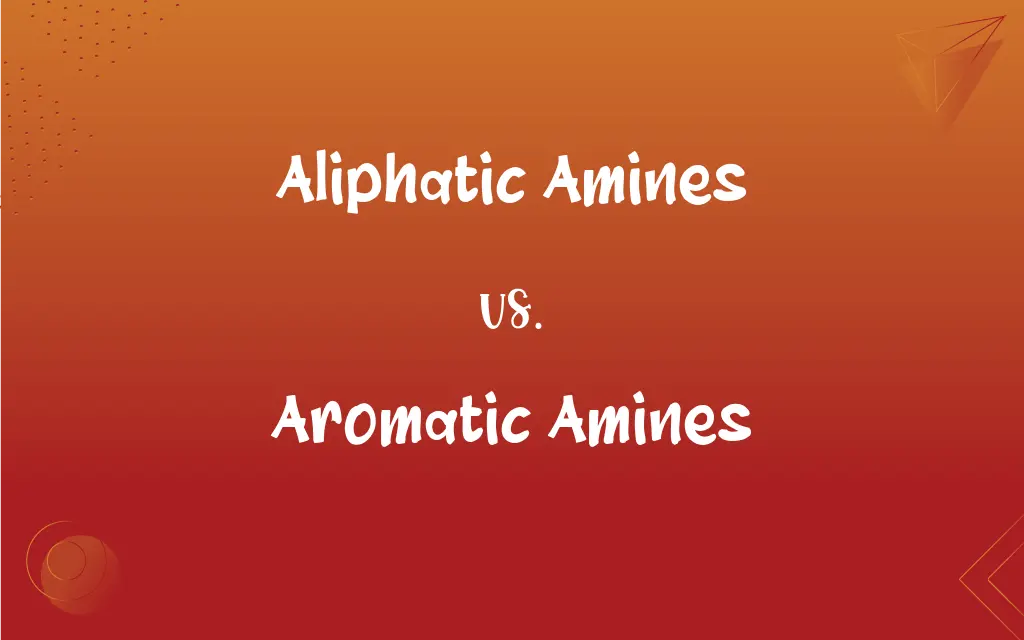Aliphatic Amines vs. Aromatic Amines: What's the Difference?
Edited by Aimie Carlson || By Janet White || Published on February 28, 2024
Aliphatic amines are amines where the nitrogen is bonded to alkyl groups, while aromatic amines have nitrogen bonded to aromatic rings.

Key Differences
Aliphatic amines consist of nitrogen atoms connected to alkyl chains, exhibiting less electron-donating capacity than aromatic amines, where nitrogen is bonded to one or more aromatic rings, making them more electron-rich.
Aliphatic amines are generally more reactive due to less delocalization of the lone pair on nitrogen, whereas in aromatic amines, the lone pair is partially delocalized into the aromatic ring, stabilizing the molecule and reducing reactivity.
Aliphatic amines are usually stronger bases compared to aromatic amines because the electron-donating alkyl groups increase the electron density on nitrogen, enhancing their ability to donate a lone pair. The aromatic ring in aromatic amines withdraws electron density, reducing basicity.
Aliphatic amines typically have lower boiling points and are less soluble in water than aromatic amines due to the less polar nature of alkyl groups compared to aromatic rings.
Aliphatic amines are often used in pharmaceuticals and dyes, being more prevalent in biological systems, while aromatic amines are widely used in the manufacture of polymers, dyes, and other industrial chemicals.
ADVERTISEMENT
Comparison Chart
Structure
Nitrogen bonded to alkyl groups
Nitrogen bonded to aromatic rings
Basicity
Generally stronger bases
Generally weaker bases
Reactivity
More reactive
Less reactive
Physical Properties
Lower boiling points, less water-soluble
Higher boiling points, more water-soluble
Usage
Common in pharmaceuticals and dyes
Used in polymers, dyes, and industrial chemicals
ADVERTISEMENT
Aliphatic Amines and Aromatic Amines Definitions
Aliphatic Amines
They are characterized by the presence of a nitrogen atom bonded to non-aromatic carbon atoms.
Ethylamine's simple structure demonstrates the basic nature of aliphatic amines.
Aromatic Amines
Aromatic amines are organic compounds with nitrogen attached to aromatic rings.
Aniline, a primary aromatic amine, is used in dye manufacturing.
Aliphatic Amines
Aliphatic amines are soluble in organic solvents and less soluble in water.
Hexylamine demonstrates the solubility characteristics typical of aliphatic amines.
Aromatic Amines
They feature nitrogen atoms bonded to one or more benzene rings.
Diphenylamine is used in rubber production, showcasing aromatic amines' industrial applications.
Aliphatic Amines
Aliphatic amines are known for their strong base properties.
Propylamine is often used in the production of pharmaceuticals due to its basicity.
Aromatic Amines
Aromatic amines are generally more water-soluble than their aliphatic counterparts.
4-Aminobiphenyl, used in dyes, exhibits the solubility characteristics of aromatic amines.
Aliphatic Amines
Aliphatic amines are organic compounds with nitrogen attached to alkyl groups.
Methylamine is an aliphatic amine used in industrial applications.
Aromatic Amines
Aromatic amines are known for their reduced basicity due to resonance.
N-Phenylanthranilic acid, derived from an aromatic amine, illustrates their weak basic nature.
Aliphatic Amines
These amines are less stable due to minimal electron delocalization.
Butylamine is more reactive than its aromatic counterparts.
Aromatic Amines
These amines are more stable due to electron delocalization in the aromatic ring.
Toluene-2,4-diamine shows the stability of aromatic amines in chemical reactions.
FAQs
Which are stronger bases, aliphatic or aromatic amines?
Aliphatic amines are generally stronger bases due to less delocalization of the lone pair on nitrogen.
Why are aromatic amines less basic than aliphatic amines?
In aromatic amines, the lone pair on nitrogen is partially delocalized into the aromatic ring, reducing their basicity.
What are aromatic amines?
Aromatic amines are organic compounds with nitrogen bonded to aromatic rings.
What are the physical properties of aromatic amines?
They have higher boiling points and are more soluble in water compared to aliphatic amines.
Are aromatic amines capable of hydrogen bonding?
Aromatic amines can also form hydrogen bonds, but their ability is somewhat reduced compared to aliphatic amines.
How do aliphatic amines differ in structure from aromatic amines?
Aliphatic amines have nitrogen attached to non-aromatic carbon atoms, while aromatic amines have nitrogen attached to one or more benzene rings.
How does the aromatic ring influence the properties of aromatic amines?
The aromatic ring withdraws electron density, making aromatic amines less basic and more stable.
What are aliphatic amines?
Aliphatic amines are organic compounds with nitrogen bonded to alkyl groups.
What is the synthesis method for aromatic amines?
Aromatic amines are often synthesized by reducing nitro compounds or through the amination of aromatic halides.
What are the physical properties of aliphatic amines?
They typically have lower boiling points and are less soluble in water.
What are the common uses of aromatic amines?
Aromatic amines are widely used in the manufacture of polymers, dyes, and industrial chemicals.
Can aliphatic amines form hydrogen bonds?
Yes, aliphatic amines can form hydrogen bonds due to the presence of a lone pair on nitrogen.
What are the environmental concerns with aromatic amines?
Many aromatic amines are carcinogenic and pose significant environmental and health risks.
Are aliphatic amines more reactive than aromatic amines?
Yes, aliphatic amines are more reactive due to less electron delocalization.
Where are aliphatic amines commonly used?
They are frequently used in pharmaceuticals, dyes, and organic synthesis.
What is the environmental impact of aliphatic amines?
Aliphatic amines can be toxic and require careful handling and disposal to minimize environmental impact.
Can aliphatic amines be found in nature?
Yes, aliphatic amines are commonly found in various biological systems and natural processes.
How does the presence of alkyl groups affect aliphatic amines?
Alkyl groups increase the electron density on nitrogen, enhancing the basicity of aliphatic amines.
Are aromatic amines naturally occurring?
Aromatic amines are less common in nature but can be found in some biological molecules.
How are aliphatic amines synthesized?
Aliphatic amines are typically synthesized by alkylation of ammonia or reduction of nitriles.
About Author
Written by
Janet WhiteJanet White has been an esteemed writer and blogger for Difference Wiki. Holding a Master's degree in Science and Medical Journalism from the prestigious Boston University, she has consistently demonstrated her expertise and passion for her field. When she's not immersed in her work, Janet relishes her time exercising, delving into a good book, and cherishing moments with friends and family.
Edited by
Aimie CarlsonAimie Carlson, holding a master's degree in English literature, is a fervent English language enthusiast. She lends her writing talents to Difference Wiki, a prominent website that specializes in comparisons, offering readers insightful analyses that both captivate and inform.































































